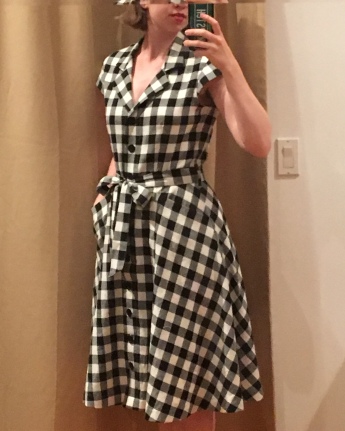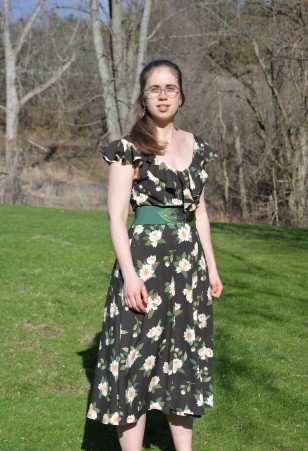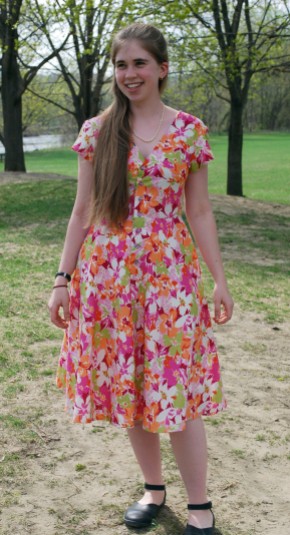The first piece of clothing I ever sewed myself was a shirt made out of knit fabric. I must have been seven or eight, and when I told my parents I wanted to sew something to wear, my mother told me I needed to get a pattern. I told her that no, I didn’t. She was dubious, but my father was game, and we just went ahead and figured it out. As I recall it had raglan sleeves and we accidentally sewed one of them on inside out. For my twelfth birthday, I got pattern drafting lessons from a local designer. I am not sure I’ve ever sewn myself a garment from a commercial sewing pattern.

By the time I was in 9th grade, I was making a significant portion of my own clothing from my own patterns – including an impressive range of comfortable but unflattering pants. Always, my patterns started one way, and then changed. Each successive garment off the same model allowed me to refine the fit. One of the two pants patterns I still use today started as a pair of pants made from four rectangles and a crotch gusset. Slowly, I refined the shapes and added curves, darts, pockets, a fitted waistband and a fly. Eventually, in college, I took courses in drafting and draping, but I was already mostly wearing clothes I’d made myself. Today, I still modify old pattern into new styles or to fit my 29-year-old body, which isn’t quite the same shape it was when I was 15.
Earlier this week I finished a dress made from a pattern which I’d originally drafted back in 2008 (when I was a junior in high school). Back then I labeled the pattern “Basic Sleeved Summer Dress.” My goal had been an uncomplicated, comfortable dress with a relaxed fit that still made a point about the wearer having a waist.
To date, I’ve made four dresses using variations on this pattern. The first at the time that I drafted the pattern (pink and orange floral), then another, with only minor changes to the neckline and sleeves, in 2009 (blue with orange belt).

Two years ago I happened across the pattern again while looking for something to do with a nice piece of black and white rayon gingham which my mother had found at a garage sale. The Basic Sleeved Summer Dress had the bones of what I was looking for, so I used it as a starting place, but made a number of modifications, repairing some of the “rookie mistakes” I’d made as a teen: poorly placed darts, a wonky shoulder line, and a too-high waist. I also added a collar, made a new sleeve, and made a pattern for the skirt – the original dress had simply had a diagram for how to cut a half-circle skirt from a 60” wide piece of fabric. This time I wanted pockets*, and I also wanted to carefully pattern match-the checks, both of which required a skirt with side seams.
This fall, I bought a few yards of a dark brown rayon printed with large white flowers from Notion, the new independent fabric store in Montpelier. It was the type of fabric where it would be a sin not to take advantage of its natural drape, but I couldn’t decide quite what I wanted to do with it. When my sketches finally resolved into a design for a flowing dress with ruffled caps sleeve and neckline, I realized that I could adapt the pattern for the gingham dress once again. Fundamentally, I still want the same things from my summer dresses: a comfortable fit, flattering line, and a little sun protection for my shoulders.

I changed the neckline and sleeves, moved the closure from center front to the side, and added a waistband. When I laid it out on my fabric, I lengthened the skirt simply by eyeballing a few additional inches of length beyond the edge of the pattern when I cut it out. I finished the dress a few days before my birthday only to realize that the very first iteration of this pattern has also been completed just in time for a birthday picnic.
The thing I love most about making my own garments (after the fact that they actually fit, that is), is the threads of connection that run between them: each one represents a stage in my own skill, or sense of style. I almost never forget where I bought apiece of fabric, or the idea which inspired a particular garment. What I like about this series of four dresses is how it illustrates this ongoing narrative of craftspersonship I am constantly having with myself as I create, refine, and make again.
*Today my philosophy is that there is no such thing as a successful garment design that doesn’t have pockets. I don’t care if it looks nice, if there’s no where for my lip balm, five dollars, and a cell phone, it doesn’t work.

